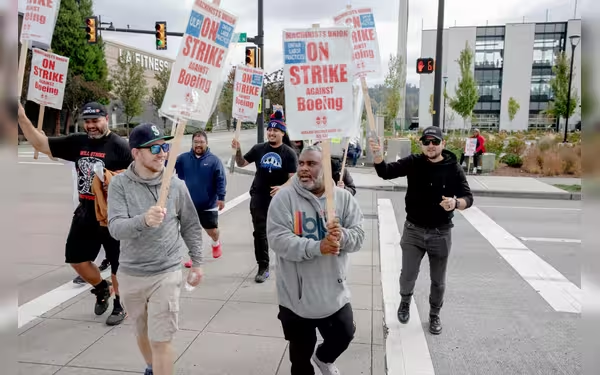Saturday, November 16, 2024 03:17 PM
Boeing Faces Extended Strike and Furloughs Thousands of Employees
- 30,000 machinists strike, halting Boeing production.
- Boeing implements furloughs amid financial difficulties.
- Negotiations ongoing, union demands exceed Boeing's offer.
 Image Credits: arabnewspk
Image Credits: arabnewspkBoeing faces a prolonged strike, furloughing thousands as negotiations with machinists continue amid financial challenges.
Boeing, one of the largest aerospace companies in the world, is facing significant challenges as it prepares for a prolonged strike. This situation arose when approximately 30,000 machinists went on strike last Friday, leading to the temporary furlough of tens of thousands of employees. The strike has halted production of Boeing's popular 737 MAX jets, along with other aircraft models, creating a ripple effect throughout the aviation industry.
In an email to employees, Boeing's CEO, Kelly Ortberg, announced that the company would implement temporary furloughs that would affect a large number of U.S.-based executives, managers, and employees. Ortberg stated, "We are planning for selected employees to take one week of furlough every four weeks on a rolling basis for the duration of the strike." This decision reflects Boeing's strategy to manage costs during a time of uncertainty.
The strike, which is Boeing's first since 2008, comes at a time when the company is already grappling with financial difficulties. Analysts have warned that a prolonged labor dispute could cost Boeing several billion dollars, further straining its finances and potentially threatening its credit rating. Ben Tsocanos, an aerospace director at S&P Global Ratings, noted, "It’s unlikely that the cuts will fully offset the costs of a prolonged strike." This highlights the precarious position Boeing finds itself in.
Negotiations between Boeing and the International Association of Machinists and Aerospace Workers (IAM) are ongoing, with federal mediators involved. However, the union has expressed frustration with the pace of discussions, feeling that Boeing is not taking the negotiations seriously. The IAM is seeking a 40 percent raise over four years, a demand that far exceeds Boeing's offer of 25 percent, which was rejected by the union.
Brian Bryant, the IAM’s international president, criticized Boeing's furloughs and salary cuts, calling them "smoke and mirrors" in light of the company's previous spending on executive bonuses. He emphasized that the resolution of the strike lies in Boeing's hands, stating, "The ball is in Boeing’s court. They could settle this strike tomorrow."
As the strike continues, it poses risks not only for Boeing but also for its extensive network of suppliers. Many suppliers are already considering furloughs, which could have a significant impact on the entire aerospace supply chain. Nikki Malcom, CEO of the Pacific Northwest Aerospace Alliance, remarked, "Certainly suppliers are worried. It’s going to have a significant impact on suppliers if it goes on a long time."
With production halted on key aircraft models, including the 737 MAX, 777, and 767, Boeing is also freezing hiring and has stopped placing most orders for parts, except for the 787 Dreamliner. This decision underscores the company's urgent need to cut costs as it grapples with a staggering $60 billion in debt.
The ongoing strike at Boeing is a critical moment for the company and the aerospace industry as a whole. The outcome of the negotiations will not only determine the future of thousands of employees but also the financial stability of Boeing and its suppliers. As the situation unfolds, it remains to be seen how both parties will navigate this challenging landscape and whether a resolution can be reached that satisfies the needs of the workers while ensuring the company's viability.













